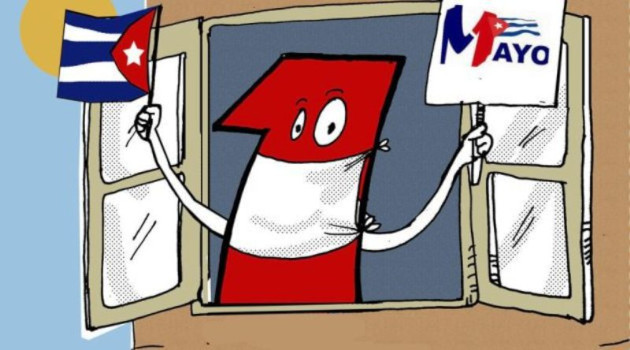The world’s first celebration of Workers’ Day took place in 1890, a date that had been agreed upon a year earlier by the Congress of the Second International held in Paris.
The Cuban proletariat had the historic honor of participating in the world premiere of Labor Day, in honor of the Chicago Martyrs, workers of an American company who were sentenced to hang in 1886 for striking for eight hours a day.
In July 1889, this congress took place with the participation of workers’ representatives from various European countries, at which they decided to create the Second International, an organization whose goals included calling for the creation of labor legislation in favor of the working class.
The French delegation took the initiative to keep in memory the sacrifices of the workers who fell in the struggle for the improvements that everyone deserved. In the Parisian event, they agreed on the initiative and it was decided that on each May Day, the workers’ groups would hold public demonstrations, in addition to demanding an improvement in their living and working conditions.
From 1890 it began to be celebrated in an increasing number of countries. The proletariat rallied around its economic and political demands.
The Cuban working class, despite its initial level of organization and the difficult colonial conditions that prevailed on the island, had the glory of being among those who celebrated this important day in the world for the first time.
From the manifesto issued on the occasion of the convocation, a broad submission to the prevailing colonialism can be deduced, since it was stated that the demonstration would take place on Labor Day “(…) so that the government, the supreme, may know the seasons and the common people or they may appreciate what are the aspirations of this working people”, which puts On the other hand, it was required that “speakers be subject to exposing only the needs and aspirations of the working class, in an orderly manner, so that our notions may clarify the opinion”.
In 1954, Pope Pius XII endorsed the celebration of this day of collective memory, declaring it the Feast of San José Obrero.
The celebration of International Workers’ Day in 1939 was the first organized by the Federation of Cuban Workers, only three months after the convening of the Constituent Congress, after a long and arduous path in favor of the unity of the proletariat. Country.
On that day, there was a large procession that started from the headquarters where Central Obrera was located at the time, at the intersection of Belascoaín and San Lázaro Streets, in Havana. The march progressed to Avenida de las Misiones, past the Presidential Palace, Paseo del Prado and ended at Central Park. Several workers’ leaders spoke at the rostrum there, among them Lázaro Peña, Secretary General of the CTC, who summed up the rally.
With the advent of revolutionary power, in January 1959, May Day became a workers’ holiday, which was joined by students, peasants, and fighters from armed institutions. The CTC and its unions arrive at the proletarian assembly not to demand work, health, medical assistance, social justice, equality in duties and rights, or other long-sought-for victories in various parts of the world.
May 1st in CIENFUEGOS
I turn to an interesting and well-argued piece of journalism from a colleague and friend who died of COVID─19, Andrés García Suárez, about the celebration of International Workers’ Day in Cienfuegos.
There is no evidence of celebration in this region on that date before the proclamation of the Republic in 1902, “but since 1919 there appears the decision of the printers from Cienfuegos who agreed not to go to work on May Day that year”.
In 1926, according to what appeared in the press at the time, the communist doctor Dr. Gustavo Aldirigia Lima spoke in Cienfuegos, whose name today bears the general and university hospital. The following year, in 1927, the revolutionary leader Rubén Martínez Villena, who succeeded Julio Antonio Mela, intervened in the direction of the first Communist Party in Cuba, founded in 1925, at the Tomas Terry Theatre.
The prominent journalist noted that “the working class of Cienfuegos has always been so militant and ideologically articulate, that its president was chosen to be the seat of the Second National Workers’ Congress, where they agreed to found the predecessor of our present central Trabajadores de Cuba (CTC)”.
It was a venue for the Cienfuegos Sports Fronton, a center for union organizing and the study of southern workers in 1933, and with the organization of the July 26 Movement (M-26-7) the city’s uprising against the dictatorship of then President Fulgencio Batista Zaldivar on September 5, 1957.
Only after the victory of the revolution in 1959, did Labor Day begin to be celebrated with great rallies of workers, students, and the people in general, and huge and happy meetings that are a privilege for those of us who live in this society. Workers, Andres García emphasized in his article.
In that year, the first revolutionary celebration of International Workers’ Day took place in Cienfuegos.
(Sources: Ecured Encyclopedia and other internet sites)

“Unapologetic tv specialist. Hardcore zombie trailblazer. Infuriatingly humble problem solver.”

:quality(85)/cloudfront-us-east-1.images.arcpublishing.com/infobae/KIARFUWUWBHWVHDKDG2ES6NR2I.jpg)
:quality(85)/cloudfront-us-east-1.images.arcpublishing.com/infobae/LU6SKOUVYNHJZERSPCRUHH7MME.jpeg)




More Stories
Verde Olivo magazine celebrates 65 years › Culture › Granma
News, situation in Ukraine and more
Israel announced it had killed a senior Hezbollah member in a drone strike in southern Lebanon